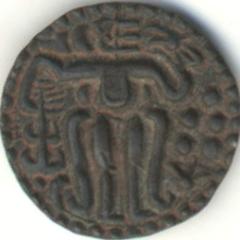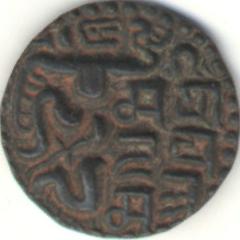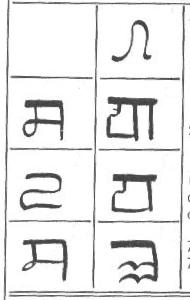| SPECIFICATIONS | |
| Denomination | massa |
| Alloy | Copper |
| Type | Struck |
| Diameter | 20.47 mm |
| Thickness | mm |
| Weight | 4.26 gms |
| Shape | Round |
| Edge | Plain |
| DieAxis | O° |


|

| 
| ||||||||||||||||||||
| Codrington #81 | Mitchiner #840-841 | |||||||||||||||||||||
|
Obverse : Traditional Lankan massa design of standing king. The head consists of an irregular oblong, the right side being a vertical line, from which projects three horizontal stokes representing the nose, mouth and chin. The crown bulging outwards at the back. The two curved lines on either side of the legs slightly turned upwards at the end indicate a person wearing a 'dhoti', and standing on a lotus stalk with flower to the right. The forearm is bent sharply down; the hand grasps the hanging lamp. The right side elbow is curved down with the arm turned upwards holds a flower presumed to be a jasmine blossom. To the right are five dots or spheres. A rim of 40 to 43 beads. Reverse : Traditional Lankan massa design of seated king. Head and crown as on obverse. Arm is raised upwards and the hand holds a conch shell. On right Nagari legend Sri ma tSa ha sa Ma lla | 
|
This is one of six fairly common copper massa coins from the late Polonnaruwa and Dambadeniya era. This coinage may well have been continued by his sister-in-law Queen Kalyanavati (1202-1208)
To quote history from the direct translation of the ancient chronicle
Culavamsa
Thereupon King Sahasamalla of the race of Okkaka, a lion in courage,
carried on the government for two years. Then having deposed this
Monarch, the general Ayasmanta, a man of almost unsurpassable courage,
a supporter of his royal family, prudently had the government carried
on with wise policy for six months by Kalyanavati, the first mahesi of
Kittinissanka. This Queen Kalyanavati, who was devoted to the Order of
the Master, had a vihara called after her, built in the village
Pannsalaka by name, for love of the village, and assigned it villages,
fields, articles of use, slaves, gardens and so forth. With her
consent, the general Ayasmanta, who administered the government in all
Lanka, who came of the Khandhavara family, sent the Adhikarin Deva to
charming Valliggama, had a vihara erected there and assigned to the
Great community. He built the parivena known by his name of
Sarakulavaddhana and caring for its support, he assigned it villages
and fields surrounded by parks and the like and which could scarcely
be visited by a bad harvest, together with articles of use and slaves
male and female. Having scrupulously separated the four castes who
had become impure through mixture, he bent on doing good, had a text
book compiled which had law as its subject.
Text edited from
* Ceylon Coins and Currency: H. W. Codrington, Colombo, 1924.
Chapter VI Mediaeval Lanka - Sinhala of 12th & 13th Century - Series I, Page 69
* Culavamsa II Chapter LXXX: Translation by Wilhelm Geiger. Pali Text Society 1930
The coin was scanned at 300dpi and displayed at 300dpi is from my original collection from Lanka.